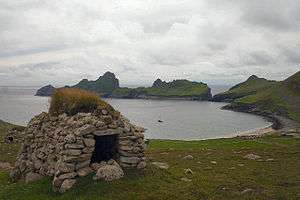St Kilda
St Kilda is the westernmost of the Outer Hebrides in Scotland, and is geographically separate enough that is could be considered its own archipelago rather than part of that chain. It is on the UNESCO World Heritage List.

There are St Kildas in the New World: in Melbourne, Dunedin and Adelaide.
St Kilda was evacuated in 1930. The only residents now are the Warden and an Army camp (including civilian contractors) giving a total population well under 50. Around 2,000 people visit St Kilda each year.
St Kilda is a chain of islands, but everything here is about the main island, Hirta. The other islands Dun, Soay and Boreray are uninhabited and rarely visited by travellers.
For a map of St Kilda, try streetmap.co.uk or use the historic maps from The National Library of Scotland.
Get in

It is recommended not to visit the island on Tuesday or Friday, because they are supply days.
Unless you own an ocean going boat, you will be visiting in an organised party, as there is no scheduled transport. The crossing can be rough, and is only sensible in calm weather. The options are:
- On a National Trust for Scotland Work Party. These are organised in the summer, and last about 2 weeks. The work is either on repairing facilities or archaeology. A cook and a work part leader travel out with the group, and various excursions are organised. These are often over subscribed, and you need to contact the NTS in the autumn for a chance of going in the following summer.
- As part of a cruise around the Western and Northern Isles of Scotland. Various week long or so cruises sometimes include St Kilda in their itinerary if the weather is suitable. Check that the cruise ship has its own smaller boats - zodiacs are ideal - for landing at the small jetty on Hirta. Winds or swell from the east or south-east may make landing impossible. However, a non-landing trip around the islands, especially going close to Boreray and the huge sea stacks covered in Gannets, can still be very worthwhile.
- On a day trip. Day trips to Hirta are possible from Outer Hebrides and Skye. These will only run when the weather permits, thus most tours request that you have two consecutive days free. Also, most tours do not include food, so lunches must be packed.
- Sea Harris, Sea Harris, East Tarbert, Isle Of Harris, HS3 3DB, ☎ +44 1859 502007, e-mail: seumas@seaharris.co.uk. 08:00-19:30. Day trips from Leverburgh, South Harris to St. Kilda followed by a cruise around Boreray and the Stacs. Tours run Monday, Wednesday & Friday (or Tuesday, Thursday, Saturday due to weather cancellations). £180/adult.
- Kilda Cruises, ☎ +44 1859 502060, e-mail: angus@kildacruises.co.uk. 08:00-19:30. Day trips from Leverburgh, South Harris to St. Kilda followed by a cruise around Boreray and the Stacs. Tours run Monday, Wednesday & Friday (or Tuesday, Thursday, Saturday due to weather cancellations). £190/adult, £90/child.
- Seatrek, ☎ +44 1851 672469, e-mail: bookings@seatrek.co.uk. Day tour to St. Kilda from Uig on the Isle of Lewis followed by a cruise around Boreray and the Stacs. Tours run Monday and Thursday (or Tuesday and Friday due to weather cancellations). £180/pp.
- Go To St Kilda, ☎ +44 77899 14144, e-mail: enquiries@gotostkilda.co.uk. 07:30-21:00. Day tour to St. Kilda from Uig on the Isle of Skye followed by a cruise around Boreray and the Stacs. £235/pp.
Get around

The only way to explore the island is on foot. As the island is only about 4 mi (6.4 km) long, everywhere on it is reachable in a day, though the slopes up to the main ridge are steep. The total length of paved road is about 1 mile (1.6 km). The walk along the main ridge has some of the most breathtaking views in Britain.
See
Before visiting St Kilda you will probably want to read one of the guidebooks dedicated to the islands. Main things to see:
- Wildlife: Puffins, St Kilda Wren, St Kilda Field Mouse, Fulmars, Bonxies and many many others.
- History: The village bay collection of houses, and the Cleits everywhere.
- 🌍 Museum. In one of the restored houses in village bay.
- Landscape: Spectacular cliffs.
- Soay sheep: Semi wild population of brown sheep.
- 🌍 Lady Grange's House. A cleit (stone shed) which was the "house" of Lady Grange (Rachel Chiesley) between 1734 and 1740. Lady Grange was the estranged wife of an Edinburgh lawyer who was kidnapped and taken first to the Monarch Isles and then after two years to St Kilda.
- 🌍 Main Street. A collection of "white houses" built in the 1860s. Several of these have been restored and are used as facilities for NTS workparties.
- 🌍 Mullach Mor. The road from village bay provides an easy route up this 357-m hill.
Do
Buy
Souvenirs may be available occasionally from either the Warden or the leader of Work Parties.
Eat
There are no eating facilities open to the public.
Drink
There are no facilities open to the public. The Puff Inn inside the army camp used to be open to visitors, but no longer.
Sleep
- The National Trust for Scotland campsite, c/o Balnain House, 40 Huntly Street, Inverness, IV3 5HR. The only accommodation on the islands is a very small campsite, which can only house six people. If travelling on a private boat it would be much wiser to spend the night on the boat. Should you wish to use the campsite you must make a reservation with The National Trust for Scotland.
The Work Parties sleep in dormitories in restored houses in village bay.
Go next